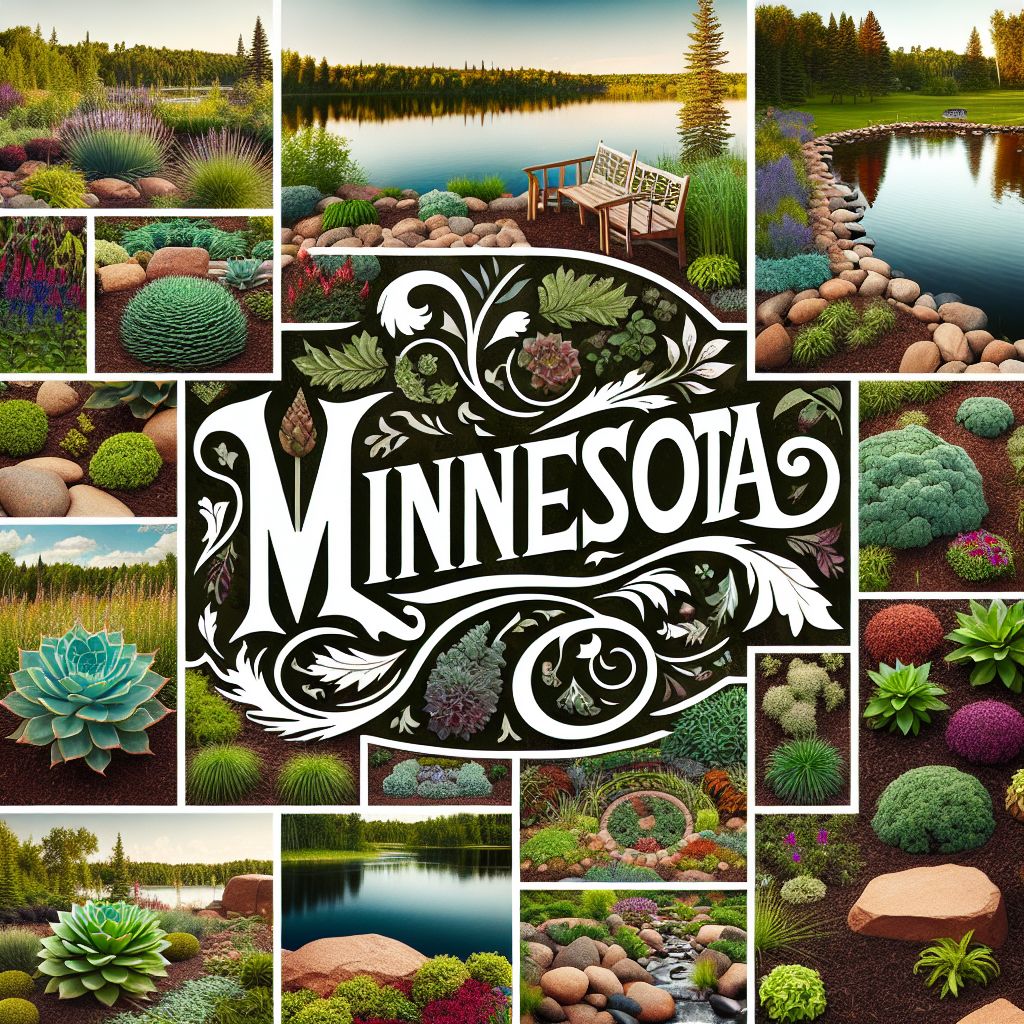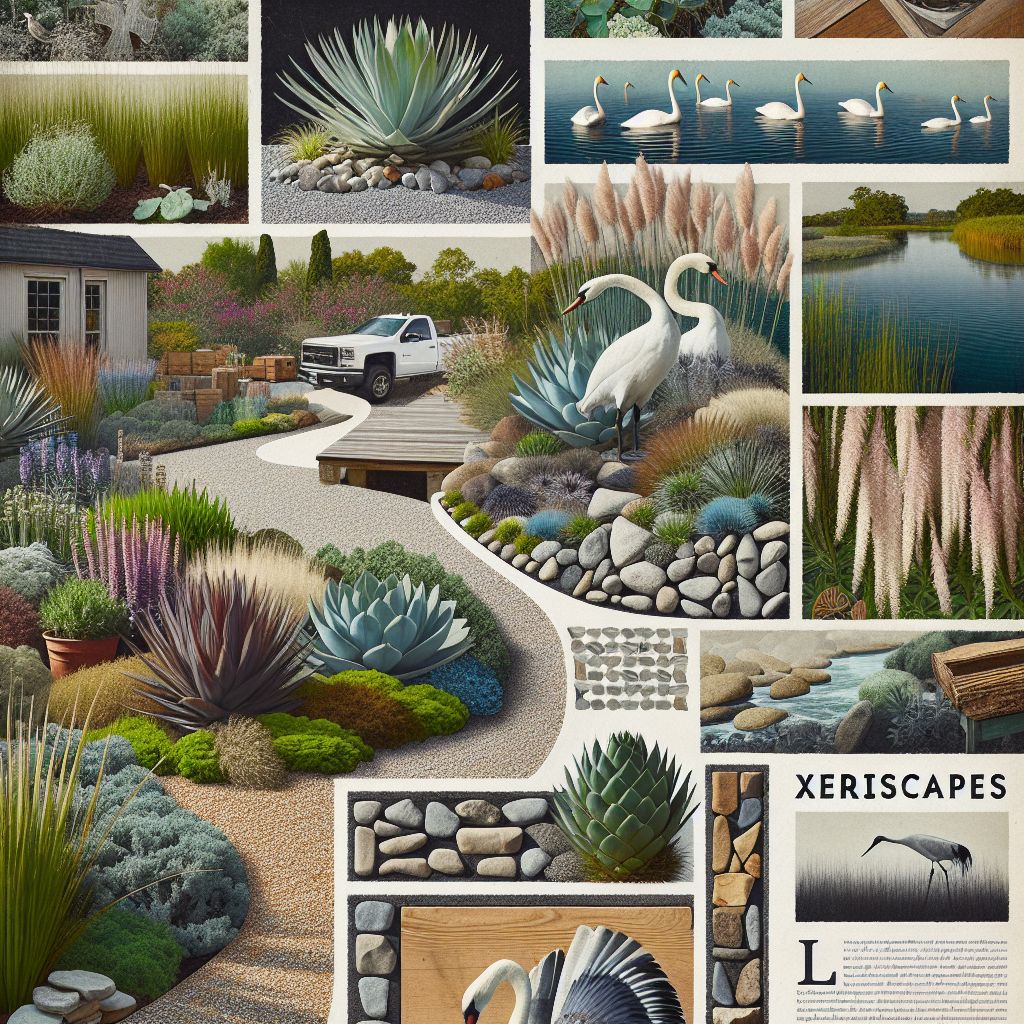
Key Takeaways
- Native plants are key to creating a low-maintenance, water-efficient garden in Minnesota.
- Xeriscaping conserves water and supports local wildlife while reducing the need for fertilizers and pesticides.
- Understanding your landscape’s sun exposure, soil type, and moisture level is crucial for successful
. - Strategic garden design maximizes beauty and functionality with minimal water use.
- Plants like Butterfly Weed, Black-eyed Susan, and Purple Coneflower are excellent choices for Minnesota xeriscaping.
Why Native Plants Are the Way to Go
Choosing native plants for your garden isn’t just about aesthetics; it’s about creating a symbiotic relationship with the local ecosystem. Native plants have evolved to thrive in Minnesota’s specific conditions, which means they are hardy and disease-resistant. They provide essential habitat for pollinators and wildlife and maintain natural biodiversity, which is crucial for a healthy and resilient environment.
When you opt for native plants, you’re making a wise choice for your garden and contributing to conserving our precious water resources. These plants require significantly less water once established, reducing the strain on Minnesota’s water supply and your own time spent on garden maintenance.
Therefore, incorporating native plants into your xeriscaping project is a smart move that will pay off with a vibrant and virtually self-sustaining garden.
- Butterfly Weed (Asclepias tuberosa) – a magnet for monarch butterflies and other pollinators
- Black-eyed Susan (Rudbeckia hirta) – a cheerful yellow bloom that brings color and life to your garden
- Purple Coneflower (Echinacea purpurea) – a hardy flower that stands tall and attracts birds and butterflies
Xeriscaping Benefits: Water Conservation and Beyond
- Reduces water usage significantly, helping to preserve local water resources.
- Supports native wildlife by providing natural habitats and food sources.
- Minimizes the need for chemical fertilizers and pesticides, promoting a healthier environment.
- Low-maintenance requirements save time and effort in garden upkeep.
- Increases property value with aesthetically pleasing and environmentally responsible landscaping.
Xeriscaping is a win-win for both the environment and garden enthusiasts. By embracing these principles, you’re not just designing a garden but actively protecting Minnesota’s natural heritage.
Ready to get started? Let’s plan your xeriscape oasis, step by step.
Planning Your Xeriscape Oasis
- Assess your yard’s conditions, such as sun exposure, soil type, and moisture levels.
- Sketch a rough design of your garden, considering areas for plants, paths, and features.
- Choose a mix of native plants that will flourish in your garden’s specific conditions.
- Plan for efficient irrigation, if necessary, focusing on the roots rather than foliage.
- Use mulch to help retain soil moisture and reduce weed growth.
Remember, the key to a successful xeriscape is to work with nature, not against it. Understanding your landscape and choosing the right plants creates a stunning, easy-to-maintain, and environmentally friendly garden.
Let’s delve into the specifics of your landscape to ensure your xeriscape thrives.
Understanding Your Landscape: Sun, Soil, and Moisture
Before you plant a single seed, it’s crucial to understand the conditions of your garden. Full sun, partial shade, soil pH, and moisture levels can all influence which plants will thrive in your space. For example, plants like the Butterfly Weed love the full sun, while others, such as the Purple Coneflower, can tolerate a bit of shade.
The soil in Minnesota varies greatly, from sandy soils that drain quickly to heavy clay that retains water. Enhancing your soil with organic matter can improve its structure and water-holding capacity, making it more suitable for xeriscaping.
Moisture levels also play a critical role. Even within the same yard, there can be dry spots and areas that retain moisture longer. Observing these patterns will guide you in placing plants in the optimal locations for their water needs.
- Full sun areas: Ideal for plants that thrive with six or more hours of direct sunlight.
- Partial shade areas: Best for plants that prefer protection from the intense midday sun.
- Soil testing: Determines pH and nutrient levels to tailor your soil amendments.
- Moisture mapping: Helps you understand where to place drought-tolerant plants and those that need more water.
With a clear understanding of your landscape, you can now design your garden layout smartly, ensuring each plant is positioned for success.
Designing Your Garden Layout Smartly
Designing your xeriscape is like painting a picture with plants. Start with a base layer of low-growing ground covers, add splashes of colour with flowering perennials, and create a structure with shrubs and trees. Pathways and rocks can add texture and form, guiding the eye and the foot through your garden.
Consider grouping plants with similar water needs together to make watering more efficient. This technique, known as hydrozoning, ensures that each plant gets just the right amount of moisture without wasting water.
Lastly, leave room for growth. Plants will spread and fill in the space over time, creating a lush, full garden that feels intentional and natural.
With your plan in hand, you’re ready to select the native plants that will become the stars of your xeriscape. In the next section, we’ll explore some of the top native plants for Minnesota xeriscaping and how to match them to your garden’s unique conditions.
Matching Plants to Your Garden’s Conditions
A successful xeriscape is not just about selecting native plants; it’s about choosing the right plants for your garden’s specific conditions. A sun-loving plant won’t thrive in a shady corner, and a plant that prefers dry soil will struggle in a damp area.
When it comes to matching plants to your garden’s conditions, there are a few key factors to consider:
- Sunlight: Observe how the sun moves across your yard throughout the day. Full sun areas are perfect for plants like the Blue Grama Grass, while woodland natives like the Wild Ginger prefer shaded areas.
- Soil Type: Is your soil sandy, loamy, or clay-heavy? For instance, the Butterfly Milkweed adapts well to dry, sandy soils, while the Red Osier Dogwood can handle wetter clay soils.
- Moisture: Some areas of your garden may retain moisture longer than others. Plants like the Swamp Milkweed are well-suited for these wetter spots.
Understanding these conditions allows you to create a harmonious environment where your plants survive and thrive with minimal intervention.

Essential Xeriscaping Techniques
Now that you’ve selected the perfect plants for your garden’s conditions let’s discuss the essential xeriscaping techniques that will help your garden flourish with minimal water and effort.
- Efficient Irrigation: Even drought-tolerant plants need water to establish. Use soaker hoses or drip irrigation to target water directly to the roots, where it’s needed most.
- Mulching: A layer of mulch conserves moisture, regulates soil temperature, and reduces weed growth. Organic mulches like wood chips or straw add nutrients to the soil as they decompose.
- Proper Plant Spacing: Give plants enough room to grow to maturity. This reduces competition for water and nutrients and improves air circulation, which helps prevent disease.
When applied correctly, these techniques will significantly reduce the need for watering, weeding, and other maintenance tasks in your xeriscape garden.
Mastering Efficient Irrigation
Water is a precious resource, and efficient irrigation is at the heart of xeriscaping. The goal is to provide your plants with enough water to thrive while minimizing waste. This is where soaker hoses and drip irrigation systems shine. They deliver water slowly and directly to the plant’s root zone, reducing evaporation and runoff.
For the occasional deep watering, do it early in the morning when temperatures are cooler to reduce water loss through evaporation. Remember, overwatering can be just as harmful as underwatering, so adjust your irrigation based on rainfall and your plants’ specific needs.
Mulching for Moisture Management
Think of mulch as a protective blanket for your garden. It keeps the soil cool on hot days, warm during cool nights, and moist in between watering.
Mulching is a critical step in xeriscaping. It helps retain soil moisture, suppresses weeds, and adds organic matter to the soil as it breaks down. Apply a 2-3 inch layer of mulch around your plants, taking care not to pile it up against the stems to prevent rot.
Choosing the right mulch is important, too. Organic mulches like shredded leaves, pine needles, or bark chips are great options for improving soil health. Inorganic mulches like gravel or river rock can also be used, especially in areas where you want to add a decorative touch or where blowing leaves might be an issue.
Weeding and Maintenance Tips
- Regular weeding keeps your garden looking tidy and reduces competition for water and nutrients.
- Deadheading spent flowers encourages new blooms and prevents self-seeding plants from spreading too much.
- Pruning and thinning out overgrown plants improve air circulation and reduce disease risk.
Maintenance is all about balance. With xeriscaping, the goal is to minimize the work over time by choosing the right plants and using the right techniques from the start.
Native Plants Showcase
Let’s highlight some native plants that are ideal for xeriscaping in Minnesota. These plants survive and thrive in the local climate, providing beauty and habitat with little to no extra watering once established.
Writing Your Garden Story with Plants
Your garden is a living story; each plant you choose adds a chapter. Native plants like the Prairie Smoke, with its whimsical seed heads, or the bold blooms of the Cardinal Flower tell a tale of resilience and natural beauty. They create a narrative that speaks to the heart of Minnesota’s landscapes.
Feature Plant 1: Butterfly Weed
The Butterfly Weed (Asclepias tuberosa) is a hero in the xeriscaping world. Its vibrant orange blooms are a feast for the eyes and a banquet for pollinators. This sun-loving plant is drought-tolerant and thrives in well-drained soils. It’s a must-have for any eco-friendly garden.
Feature Plant 2: Black-eyed Susan
Black-eyed Susan (Rudbeckia hirta) is the sunshine of the prairie. It’s golden petals and dark centres light up any garden. This plant is incredibly versatile, tolerating a range of soil types and moisture levels. It’s also a favorite of butterflies and birds, making it an excellent choice for a wildlife-friendly xeriscape.
Feature Plant 3: Purple Coneflower
The Purple Coneflower (Echinacea purpurea) is a staple in any xeriscape garden. This sturdy perennial stands up to drought, blooms throughout the summer, and its purple-pink flowers are loved by butterflies and bees alike. It’s a medicinal plant known for boosting the immune system. Coneflowers prefer full sun but can manage in partial shade, making them versatile for various garden spots.
Minnesota Xeriscaping: Best Native Plants
| Plant Name | Sun Exposure | Watering Needs |
|---|---|---|
| Buffalo Grass | Full Sun | Low – Drought-tolerant once established, but can be tricky to grow from seed. Consult with the local MN Extension office for the best cultivars. |
| Black-Eyed Susans | Full Sun | Low – Thrives in well-drained soil and requires little maintenance once established. Deadhead spent flowers to encourage more blooms. |
| Hostas | Partial Shade | Moderate—It prefers moist, well-drained soil. Water deeply during dry spells. Divide clumps every 3-4 years to maintain vigor. |
| Ostrich Fern | Partial Shade | Moderate – Grows best in consistently moist, humus-rich soil. Mulch to retain moisture. |
| Sumac | Full Sun | Low – Drought-tolerant and grows well in poor, dry soil. Prune suckers to control spread. |
References:
Minnesota Landscape Arboretum. (n.d.). Native Plants for Minnesota Gardens. Retrieved from https://arboretum.umn.edu/nativeplants.aspx
University of Minnesota Extension. (n.d.). Lawn Alternatives. Retrieved from https://extension.umn.edu/lawn-care/lawn-alternatives
Minnesota Nursery & Landscape Association. (n.d.). Native Plants for Minnesota. Retrieved from https://www.mnla.biz/page/NativePlants
Lady Bird Johnson Wildflower Center. (n.d.). Native Plant Database. Retrieved from https://www.wildflower.org/plants/
Creating a Framework for Your Garden
Structuring your garden with hardscaping elements like rocks, paths, and borders adds visual interest and reduces the amount of space that needs watering and maintenance. Incorporating sustainable decor, such as birdhouses, bee hotels, and native grasses, can enhance the garden’s appeal and functionality.
Structuring Spaces with Hardscaping
Hardscaping is the backbone of your garden’s design. It’s the non-living elements that provide structure and form. For example, a winding gravel path invites exploration, while a strategically placed boulder can create a focal point. These elements define spaces, direct foot traffic, and reduce the area that requires watering and upkeep.
Incorporating Sustainable Decor
Besides plants, consider adding sustainable decor to your xeriscape. Bird baths, insect houses, and native wood benches add charm and encourage wildlife to visit. These features support the local ecosystem and bring your garden to life with the sounds and activities of nature’s visitors.

Frequently Asked Questions (FAQ)
How Often Should You Water a Xeriscape Garden in Minnesota?
Initially, your xeriscape garden will need regular watering to help plants establish their root systems. Once established, most native plants will require minimal additional watering. Depending on rainfall, you might water deeply once a week during the peak of summer. Always check the soil moisture before watering; overwatering can be as detrimental as underwatering.
Remember, the beauty of xeriscaping is that it’s designed to minimize the need for supplemental water. After the first year or two, you’ll find that your garden requires very little water beyond what nature provides.
Which Native Plants Attract Pollinators in Minnesota?
Many native plants are excellent for attracting pollinators. Here are a few favorites:
- Bee Balm (Monarda fistulosa) – attracts bees, butterflies, and hummingbirds
- Joe-Pye Weed (Eutrochium purpureum) – a magnet for butterflies and bees
- New England Aster (Symphyotrichum novae-angliae) – beloved by a variety of pollinators
- Goldenrod (Solidago spp.) – provides late-season nectar for bees and butterflies
Can You Xeriscape on a Sloped Yard?
Absolutely! Sloped yards can benefit greatly from xeriscaping. The key is to use terracing or retaining walls to create level planting areas that reduce water runoff. Ground covers and deep-rooted native plants can help stabilize the slope and utilize rainwater efficiently.
What are Some Ground Covers for Xeriscaping in Cold Climates?
Ground covers are essential for xeriscaping as they reduce soil erosion and moisture loss. Consider these ground-hugging plants in cold climates: Explore our comprehensive guide on xeriscaping in cold climates for more detailed information.
- Creeping Thyme (Thymus serpyllum) – hardy and drought-tolerant
- Bearberry (Arctostaphylos uva-ursi) – evergreen and can handle snowy winters
- Prairie Smoke (Geum triflorum) – native to Minnesota and provides early spring blooms
- Wild Strawberry (Fragaria virginiana) – spreads easily and offers small, edible fruits
How to Transition Your Traditional Lawn to a Xeriscape?
Transitioning to a xeriscape doesn’t have to happen overnight. Start by gradually reducing your lawn size and replacing sections with drought-tolerant native plants. Incorporate mulch and hardscaping elements to cover bare soil and reduce water needs. Over time, you can expand these areas and introduce more variety, creating a full-fledged xeriscape garden.
Most importantly, remember that xeriscaping is a process. It’s about building a garden that aligns with the natural environment, supports wildlife, and conserves resources. With patience and the right choices, you’ll have a garden that looks good and does good.
Minnesota’s climate can present unique challenges to landscaping, but with the right approach, you can create a beautiful, sustainable yard. Xeriscaping in Minnesota involves using native plants that are well-adapted to the local climate and soil conditions. These plants require less water, fewer fertilizers, and minimal maintenance, making them ideal for low-maintenance landscaping. By incorporating native grasses, wildflowers, and shrubs, you can design a garden that thrives in Minnesota’s weather extremes, from hot summers to cold winters.




Leave a Reply